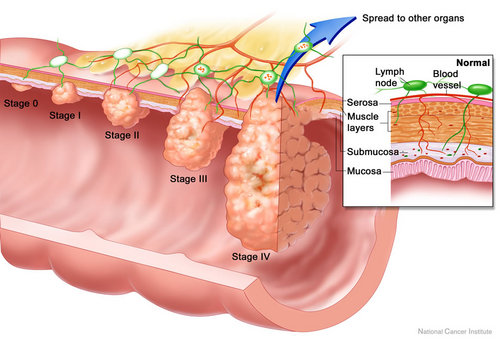



Cancer Staging
Staging is about the extent of a patient’s tumour and the spread of that tumour ... it is about the severity of the cancer
Staging determines the anatomic extent of disease.
Staging is important to determine prognosis, treatment options and decision making, benchmarks for future comparison and for ease of discussion.
Physical examination, laboratory investigations, diagnostic imaging, surgical and pathological findings all contribute to staging.
Staging Systems - TNM
There are a variety of systems for staging, the most common is TNM[1]
Tumour
size, extent and location
usually 0-4
Nodes
lymph node involvement
usually 0-3
Metastasis
presence or absence of distant metastases
usually 0 or 1
The following examples are to help you to understand the concept of staging, it is not necessary for you to know specific systems or disease sites.
Primary Tumor (T) | TX | tumor cannot be evaluated |
| T0 | no evidence of primary tumor |
| Tis | carcinoma in situ (early cancer that has not spread locally) |
| T1, T2, T3, T4 | size and/or extent of the tumor |
Regional Lymph Nodes (N) | NX | nodes cannot be evaluated |
N0 | no nodal involvement
| |
N1, N2, N3 | nodal involvement (number and/or extent of spread) | |
Distant Metastasis (M) | MX | cannot be evaluated |
M0 | no evidence of metastasis
| |
M1 | metastasis
|
A number may be added to each letter to indicate tumour size degree of spread.
Most cancers can be assigned TNM classification. CNS tumours are classified according to cell type and grade, lymphomas have a different staging system and and hematological malignancies are considered differently again.
For many cancers, TNM designations correspond to one of five stages. Criteria for stages differ for different types of cancer. For example in bladder cancer T3 N0 M0 is stage III; however; in colon cancer T3 N0 M0 is stage II.
Stage | Definition |
Stage 0 | Carcinoma in situ (early cancer that is present only in the layer of cells in which it began) |
Stage I
Stage II Stage III | Higher numbers indicate more extensive disease: greater tumor size, and/or spread of the cancer to nearby lymph nodes and/or organs adjacent to the primary tumor |
Stage IV | The cancer has spread to another organ. |
In movies the person with cancer always seems to say "I have stage 4 cancer... and there is no stage 5."

Staging example - Bowel cancer
Please don’t memorize this, it is just an illustration of staging.
stage 0 - carcinoma in situ - tumour limited to the mucosa, no invasion of the lamina propria
stage I - tumour invades the submucosa, no lymph nodes
stage II - tumour invades the muscularis propria, 2 a = T3N0M0, 2b = T4N0M0
stage III - tumor invades through the muscularis propria into the subserosa or into nonperitonealized pericolic or perirectal tissues, 3 a = T1N1M0 or T2N1M0, 3b = T3N1M0 or T4N1M0, 3c = anyTN2M0 (N1=1-3 regional nodes n2=4+ regional nodes)
stage IV Tumor directly invades other organs or structures and/or perforates visceral peritoneum - any T any N, M1
Summary staging can be used for all types of cancer and uses five main categories:
In situ | early cancer that is present only in the layer of cells in which it began |
Localized | cancer that is limited to the organ in which it began, no evidence of spread |
Regional | cancer that has spread beyond the primary site to nearby nodes,organs and tissues |
Distant | spread from the primary site to distant organs or lymph nodes |
Unknown | used when there is not enough information to assign a stage |
_________________________________
1. National Cancer Institute - NCI American Joint Committee on Cancer. AJCC Cancer Staging Manual. 6th ed. New York, NY: Springer, 2002. http://www.cancer.gov/ accessed March 12, 2008
 Previous
Previous